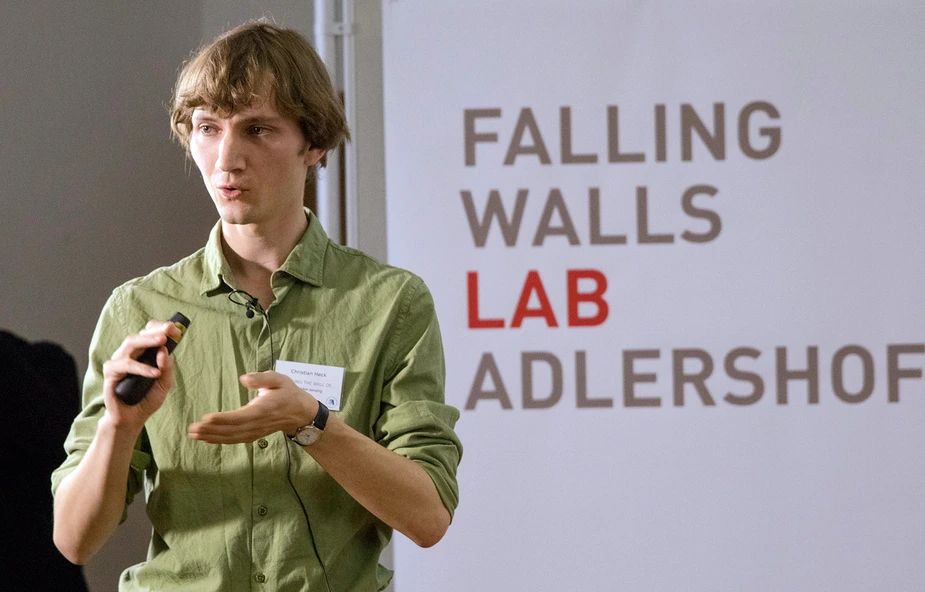Breaking Down Walls
Young scientists presented ideas for the world of tomorrow at the first Falling Walls Lab Adlershof
Breaking down walls of biomarker sensing: how to detect biomarkers in a drop of blood using laser analysis and DNA origami. This is the ultra-condensed version of the idea of Christian Heck, a biochemist at SALSA, the graduate school of Humboldt-Universität zu Berlin (HU), University of Potsdam and the BAM Federal Institute for Materials Research and Testing, who won the Adlershof preround for the Falling Walls Lab 2017.
He will go up against 99 other young scientists from all over the world, who also prevailed in local competitions, at this year’s Falling Walls Conference in Berlin on 8th November. The three winners not only receive prize money but also an opportunity to present their project to a large international conference audience.
The Falling Walls Conference has been taking place on the day of the fall of the Berlin Wall every year since 2009. One of the founding fathers is Professor Jürgen Mlynek, former president of the HU and the Helmholtz Association of German Research Centres. “Falling Walls is wonderful brand in a world that keeps building new walls – on the boarder of Mexico, through trade barriers or fake news,” he said in his opening address. Building bridges and overcoming barriers is the motto of the event at which 20 international top-level researchers present their seminal projects. It is a unique forum to identify solutions to global trends and challenges, exchange knowledge and network. The emeritus Mlynek encouraged the young scientists participating in the Adlershof Lab to pursue their own ideas, overcome setbacks and literally keep an eye on the prize: why not become company founder and roll up in a Porsche one day?
Taking part in the Adlershof Lab could be step in the right direction. Eight young scientists, among them two women, had exactly three minutes to present their “wall-breaking ideas” to a panel of six jurors. Not an easy feat, as the head juror Professor Ulrich Panne, president of BAM, underscored. However, it is a valuable experience and good training. Most often in life, one does not have much time to persuade – whether it’s a wedding proposal, business concept or innovative research ideas.
The ideas presented in Adlershof ranged from biomimetic strategies in architecture, to innovative concepts for creating affordable housing, to new formats for communicating science and interdisciplinary cooperation to quantum communication. Determining the top three was anything but easy, said Ulrich Panne upon opening the award show. The most important criteria: breakthrough factor, relevance and impact, and the speaker’s performance.
Christan Heck did an excellent job. He started his presentation with a drop of blood, where diseases are traceable at a very early stage. He wants to refine the laser-based Raman spectroscopy method to identify such biomarkers in very low concentration. To amplify the signals, he uses nanoparticles of gold or silver, which act like magnifying glass. This requires the nanoparticles to be arranged precisely in the trajectory of the optical path. For this purpose, Christian Heck uses DNA origami, a method that makes use of the unique properties of DNA – including the nanoparticles attached to them.
It is not easy to put his own research in a nutshell in three minutes for outsiders, Heck admits. He will continue to work on his presentation in preparation of the grand finale. Nevertheless, the young scientist’s enthusiasm for his subject was palpable.
Mahmoud Tawfieq from the Ferdinand-Braun-Institute, Leibniz-Institut für Höchstfrequenztechnik, came in second place. Tawfieq also aims at breaking down barriers to the diagnosis of diseases. His idea will facilitate distinguishing malicious tumours from healthy structures using a special method based on the analysis of infrared light, which is scattered on suspicious tissue.
Facundo Gutierrez came in third place. He researched his idea at the “Image Knowledge Gestaltung” excellence cluster: exoskeletons and prosthetics supporting the movement of amputees could work without thousands of mechanical and electrical components. Instead, he plans on exploiting the properties of pine cones, which are able perform certain mechanical movements due to their material properties.
By Uta Deffke for Adlershof Journal
